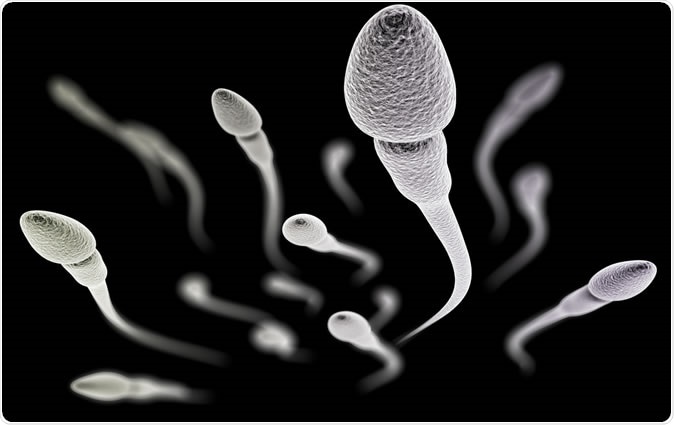A new study published in the journal PNAS shows that some sperm cannot swim straight because they lack a protein called VSP. This motility defect seriously impacts the rates of successful fertilization. In addition, VSP is also found to regulate the amount of calcium that enters the flagellum, the whiplike organelle that propels the sperm towards the waiting ovum or egg. This important discovery may help treat infertility more effectively.
Sperms are the male reproductive cells, responsible for fertilizing the egg so that conception of a new human organism is achieved. In order to do this, in nature, the sperms must travel up from the cervix through the uterus to the fallopian tubes, where the egg is typically waiting. This journey depends on the activity of their long lashing tail-like flagella. Over the course of this journey, influenced by various molecules in the uterine environment, they undergo a process called capacitation which is essential to fuel the last desperate race towards the egg. During this power surge, calcium ions flood into the flagellum to activate the cellular motor that propels these tiny cells forward.

Visualization of the sperm with (electronic microscope simulation) - Illustration Credit: 3dmotus / Shutterstock
VSP protein
Prior research has uncovered the presence of a protein called VSP in the sperms of multiple species of animals. VSP stands for Voltage Sensing Phosphatase. This protein serves to sense electrical signals, but its role in fertilization remained unclear.
The VSP protein has a unique structure, according to the researchers. Not only does it have a domain that senses changes in voltage, but it has a second domain that hosts a phosphoinositide phosphatase enzyme. The molecular activity of this enzymatic domain is well characterized and has been shown to respond to the sensing of voltage changes by the electrical sensing domain.
The study
The current study aimed to discover what exactly this protein does in the sperm. The researchers first created a mouse line lacking the gene for this protein – a knockout line – so that they could retrieve sperm that lacked VSP.
The immediate change was obvious – sperms without VSP could not fertilize eggs under laboratory conditions. On examining them closely, the reason for the reduced rate of fertilization turned out to be their tendency to swim in circles during capacitation, rather than forwards towards the ovum. The result of such undirected motility was that most of these sperms never made it to the egg at all.
Motility is linked with the flagellum, so that’s where the researchers directed their interest next. They found that there was a clear difference in the molecular structure of the normal sperm and the VSP-deficient sperm.
In normal sperm, there is a high concentration of a lipid molecule called PIP2 near the head of the sperm, at the top of the flagellum. However, this pattern was lost in VSP-deficient mice. Here the PIP2 molecules were expressed more generously but also more randomly, throughout the flagellum, instead of being localized near the head.
Sperms lacking VSP also showed very high levels of calcium ions.
The implications
The researchers think these findings suggest that VSP is crucial in regulating the activity of ion channels through which calcium ions pass, thus affecting the sperm’s motility. They have put forward a tentative mechanism to explain this hypothesis. According to them, the protein VSP is essential for the localized distribution of PIP2 in the top or midpiece of the sperm flagellum. PIP2 in turn opens potassium ion channels, as a result of which calcium ions can also enter the cell in a localized manner to enhance sperm motility.
However, the dispersion of PIP2 that occurs in VSP-deficient mice selectively promotes increased activation of the Slo3 type of potassium ion channels in the principal piece of the flagellum, where PIP2 molecules are normally present at low concentrations only. This leads to an excessive calcium ion influx. The very high calcium ion concentrations ‘jam’ the flagellum, making it stiffer and less able to propel the sperm forwards.
In other words, VSP ensures an optimal polarized distribution of the PIP2 molecule in the flagellum, with fewer molecules in the principal piece and more in the midpiece. This means that such a distribution pattern is vital to the proper regulation of ion channels and sperm motility, directly affecting fertilization.
Researcher Yasushi Okamura says this discovery could significantly affect male infertility therapy. “We predict that our findings will lead to the development of fertility treatments that enhance sperm motility, increasing the chances of fertilization.”
Source:
Journal reference:
Polarized PtdIns(4,5)P2 distribution mediated by a voltage-sensing phosphatase (VSP) regulates sperm motility Takafumi Kawai, Haruhiko Miyata, Hiroki Nakanishi, Souhei Sakata, Shin Morioka, Junko Sasaki, Masahiko Watanabe, Kenji Sakimura, Toyoshi Fujimoto, Takehiko Sasaki, Masahito Ikawa, Yasushi Okamura Proceedings of the National Academy of Sciences Nov 2019, 201916867; DOI: 10.1073/pnas.1916867116, https://www.pnas.org/content/early/2019/11/26/1916867116